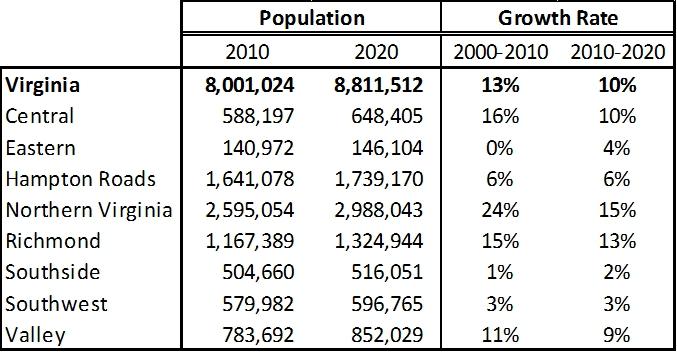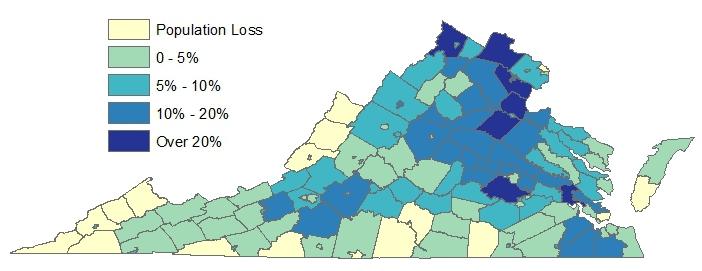Virginia Population Projections
We’ve just released the new 30-year population projections for Virginia, its 134 localities, 22 planning districts, and large towns – projections of total population; population by age, sex, and race; and population by age, sex, and ethnicity. So there’s a lot of data involved. We’ll be blogging about it more in the days to come.
Today, I want to highlight the projections for total population. The state is projected to grow by more than 800,000 people in each successive decade, reaching 10.5 million by 2040, but this growth isn’t evenly distributed across the state. The table below shows the projected 2020 population and growth rate by region compared to the 2010 Census counts.

Nearly half of Virginia’s projected growth in 2020 (392,989 out of the 810,488 increase) is in Northern Virginia, continuing the pattern from the past decade. Northern Virginia will remain the fastest growing region, but the growth rate is expected to decline in the future. We’ll still see big changes there, of course – when you’re starting with such a big population, even a small growth rate produces a big increase in population – so Northern Virginia, will continue to gain in the share of the state’s population, from 32% in 2010, to 34% in 2020 and 36% in 2040.
The following map shows the projected 2010-2020 growth rate by locality.

The pattern of projected growth rate in 2020 is similar to the growth rate in 2010 – it would be curious if it were not – but while 22 localities experienced growth rates of more than 20% between 2000 and 2010, only 7 localities are projected to maintain growth rates of more than 20% in 2020 (Chesterfield County , Frederick County, James City County, Loudon, Prince William, Spotsylvania County, and Stafford County). Areas with older populations and more out-migration – in the Southwest and Southside regions – are projected to experience continued low or stagnant growth in the next decade.
The big caveat: Projections about the future are always fraught with uncertainty; many relevant factors could change in ways no one foresees. These population projections rely on the assumption that future population is a function of the past demographic trends. They aren’t forecasts or predictions based on alternative scenarios, but represent a possible outcome should the trajectories estimated from the past sixty years continue in the future. [Updated: Edited for clarity.]
For more on Virginia population projections, visit our projections page.


